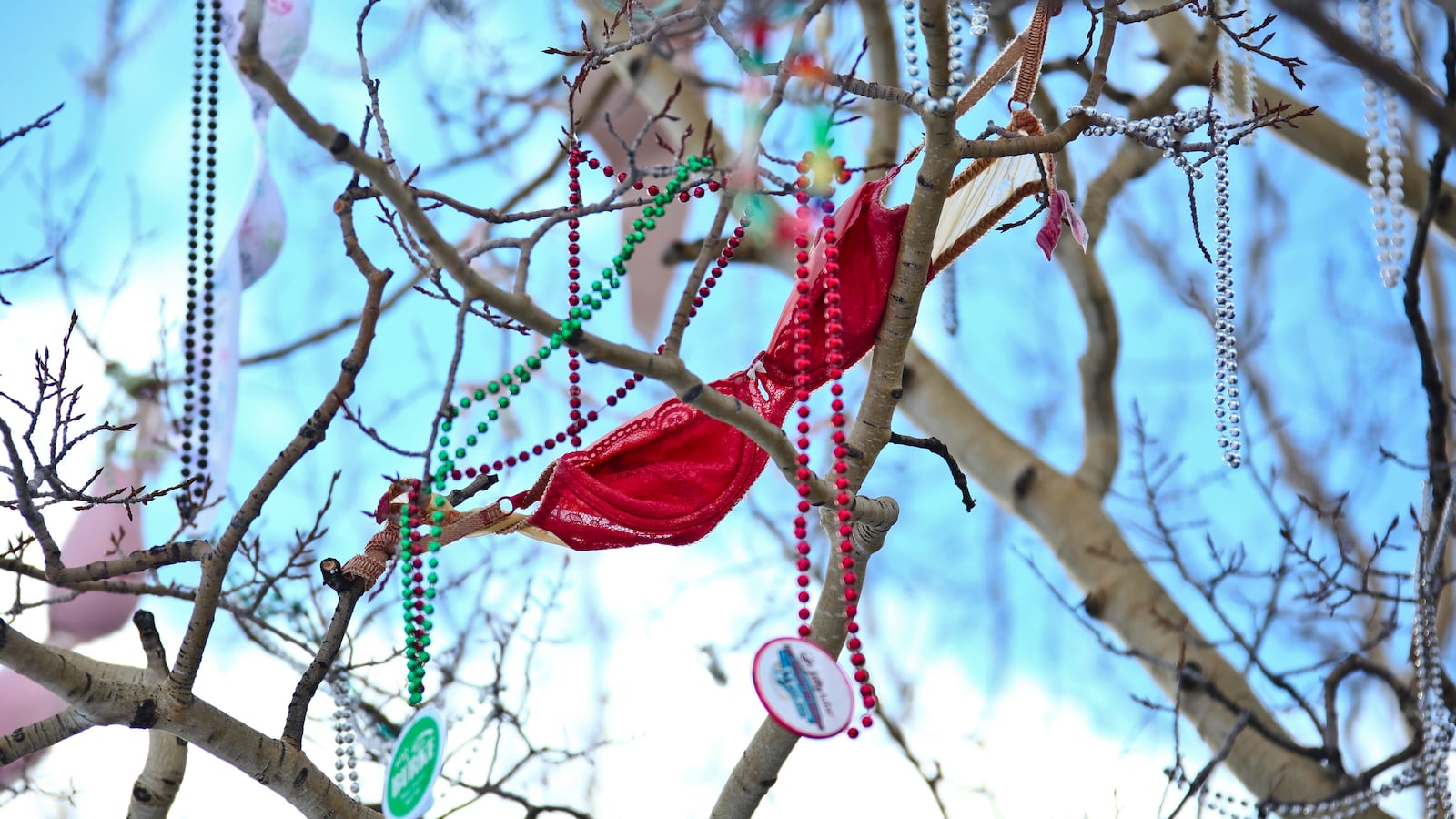Shiny magenta bras, metallic Mardi Gras beads in green, silver, and purple. Black lace panties and dowdy white underwear. Visit nearly any ski resort in the United States, and a handful in Canada, and you’ll see a tree decorated with colorful undergarments, its branches holding both natural white snow and a smattering of women’s lingerie.
At Mount Snow in West Dover, Vermont, the main bra tree is along the Bluebird chairlift, but other trees near the snowboarder’s freestyle park are also dressed with beads and bras. I’ve never actually seen anyone in action, though I’ve mused about the logistics—and risk of frost bite—of removing one’s bra while riding up a chair lift.
But of course, adding to the 50-year-old tradition requires planning ahead, premeditation on the part of participants looking to add a piece of tawdry or stylish flair to a ski resort’s unofficial designated bra tree.
The tradition, according to legend and an amusing piece of reporting by Sierra Shafer in a 2018 issue of Powder Magazine, it all started in Aspen. It was the early ’70s, women were being hired alongside men to work as ski patrols, and one disgruntled patrolman, unhappy with this turn of events, demonstrated his stance by throwing a woman’s nursing bra on a tree.
Few people I spoke with for this story were familiar with this history, however, and Aspen Mountain Ski Patrol did not respond to a request for comment on the skiing lore. (Shafer says she didn’t receive any pushback when she was reporting her story.) Aspen’s Vice President of Communications Jeff Hanle wrote in an email: “While we are aware of the trees, and have had people tell us before that they originated here, there is no one who can actually verify that fact.”
Although I’d been looking not only to discuss the bra tree’s Aspen origins but also its evolution and how it’s viewed in the community, Hanle merely stated, “I’m not sure if there is any real light we can shed on this subject,” and did not respond to my follow-ups.
And yet the trees aren’t quite in danger of extinction. They continue to pop up each year, some less robust with undergarments and beads than others but a nonetheless distinct part of the mountain’s landscape. Nathan Rafferty, CEO of Ski Utah has no problem with the trees, but acknowledges that there’s little he could do if he did. “It’s really tough to control because [the trees] are really easy to create and they kind of organically build upon themselves,” said Rafferty.

“No one knows for sure how many exist,” said Colorado Ski CEO Melanie Mills, who expressed concern over the impact of plastic-containing “unmentionables” on trees, saying, “This is a practice whose time has definitely come, and gone.”
Not everyone sees it that way though. Rafferty calls the tradition a “harkening back to the old freewheeling ski bum days,” something we “need more of in the ski industry these days, not less.”
Seth Masia, the president of International Skiing Historical Association expresses similar sentiments: “For the baby boomer generation, skiing was a really rowdy scene. It was the birth of the freestyle movement. It was the early days of the sexual revolution. It was the early days of the pill.”
He goes on, “The pickup culture in the bars was a main part of the ski weekend, and I don’t think that’s the case anymore.” This change has led to a change in social attitudes, explained Masia, who also notes he’s never heard anyone object to the existence of the trees.
You can still find traces of skiing’s debauchery, but it’s much more of a family-friendly sport these days for people of means. The freewheeling ski bum days and raucous, rowdy atmosphere that both Rafferty and Masia referenced with more than a hint of nostalgia are decidedly at odds with skiing’s current image. Even with the corporatization of the ski scene and the proliferation of ski passes like Epic, Ikon, and Mountain Collective which allow skiers and snowboarders access to participating resorts around the country (and beyond) as opposed to buying a single day’s lift ticket (a weekday at Aspen Snowmass in January is $204 and $126 at Stratton, for example), it’s hardly a budget-friendly sport. Factor in ski rentals and boots, proper attire to prevent frostbite, sticker-shock hot chocolate and bowls of chili, to say nothing of the cost of a full-fledged ski vacation requiring accommodations and lessons for children, and the sport can arguably be categorized as one for the privileged few.
I first started skiing in high school in the late ’90s when I joined the ski club, but it wasn’t until my early thirties that I returned to the sport with a renewed interest. Epic and Ikon had yet to enter the scene, but the mountains I frequented in New York and Vermont were filled with families and groups of kids in ski school, far outnumbering the people my age who might’ve enjoyed a debauched weekend here or there — panties on the tree the next day to prove it, perhaps.
Skiing’s changing demographics may help explain why once-full trees now sometimes boast just a couple of sparse items—a pair of panties here, a set of metallic beads there. It’s difficult to drape a pair of panties on a branch, said Masia, who attributes the challenge to both wind and a dark beetle infestation that led many ski resorts to cut down thousands of mature trees, putting chair lift riders out of reach of accessible tree hooks.
Julie Hughes, who lives in Toronto and has been racing and skiing mostly in Ottawa’s private ski clubs for decades, thinks the trees are a hoot. Every year, the ski clubs have something called Women’s Day—“a drunken, outrageous” event—that involves quite a lot of bra tree decorating, explains Hughes, who admits skiing takes a backseat to the drinking and dancing prevalent on Women’s Day, where women traditionally pocket their “least favorite bra” with the intention of adding to the resort’s bra tree. “It’s fun. Skiing can be such a buttoned up thing,” Hughes said.
Salt Lake City local Megan Skiles is also on board with this way of thinking. “For me, bra trees are old school expressions of the subculture and the ideas behind it like freedom, non-conformity, and, of course, there’s the party scene.” A more common expression of these ideas is seen in the group of snowboarders unabashedly bringing a case of beer up on the lift, or the stranger sitting next to me asking if I mind if he smokes some weed (not at all, and can I have a hit? I almost asked the other day but didn’t). With the sweeping changes around the legalization of cannabis around the country, it may be inaccurate to view toking up on the chairlift as representative of counter-culture or nonconformist behavior, but, like the bra tree, it’s a part of decades-old freewheeling ski days that refuses to die, and I am here for it.
From California to Maine, the bra tree (minimalist or otherwise) persists, its funky decor juxtaposed against the natural color palate of the mountain. Rich Stoner, an avid skier who runs the ski and snowboard blog All About Aprés, said he hopes the bra trees stick around, “if for nothing else than to maintain some of the ski culture that continues to dwindle as the sport becomes increasingly more corporate.” Plus, his three daughters, aged 9, 10, and 13, get a real kick out of them.
You can’t help but stare at the decorated trees when you’re riding up the lift, the bras and panties good for a giggle, Shafer, though, suggests a change may be in order after all these years: “Maybe we need to see more men's underwear up in those branches, just to keep things egalitarian.”

